Disclosure: Meeple Mountain received a free copy of this product in exchange for an honest, unbiased review. This review is not intended to be an endorsement.
In 2008, Matt Leacock introduced the world to Pandemic, a game where players work together to control four virulent diseases before the world is overwhelmed by outbreaks and all the players lose. While Pandemic wasn’t the first cooperative game, with over 5 million copies sold, it’s by far the most well-known.
Since its release, Pandemic has spawned three expansions, numerous official spin-offs, and three legacy games. Pandemic is still constantly mentioned in lists of the best cooperative games, so when it was announced in 2022 that Leacock had designed a new co-op game, the gaming world took notice. With just under 9,000 backers, Leacock’s new game, Daybreak, brought in 6 times its target goal.

Daybreak is about another threat to the planet: carbon emissions and their effect on global temperature. Your goal is to reduce your carbon emissions to an environmentally sustainable level while surviving the planetary crises that arise each round.
Setup
Players will take on the roles of one of four nations/groups of countries (US, Europe, China, and everyone else, known as the Majority World). The game provides a starter set of five cards (known as Local Projects) for each player. Lay them out above your player board, as this will make up your primary playing area throughout the game.
Along with your player board, you’ll also get a reference card that details the amount of clean and dirty energy you’re producing. You’ll also be given a list of the different amounts/types of dirty emissions your area is producing. Fill in the appropriate rows with the proper tokens. Then take the listed number of Resilience and Communities in Crisis tokens and place them in their appropriate areas. Make note of the amount your region’s starting power demand, as this will increase at the start of each turn.

On the playing board, set out a number of Ocean and Tree tokens based on the number of players. Also place the six Planetary Effects tokens at the leftmost square of their track, along with the corresponding six-sided die. Place the temperature bands at the bottom of the thermometer.
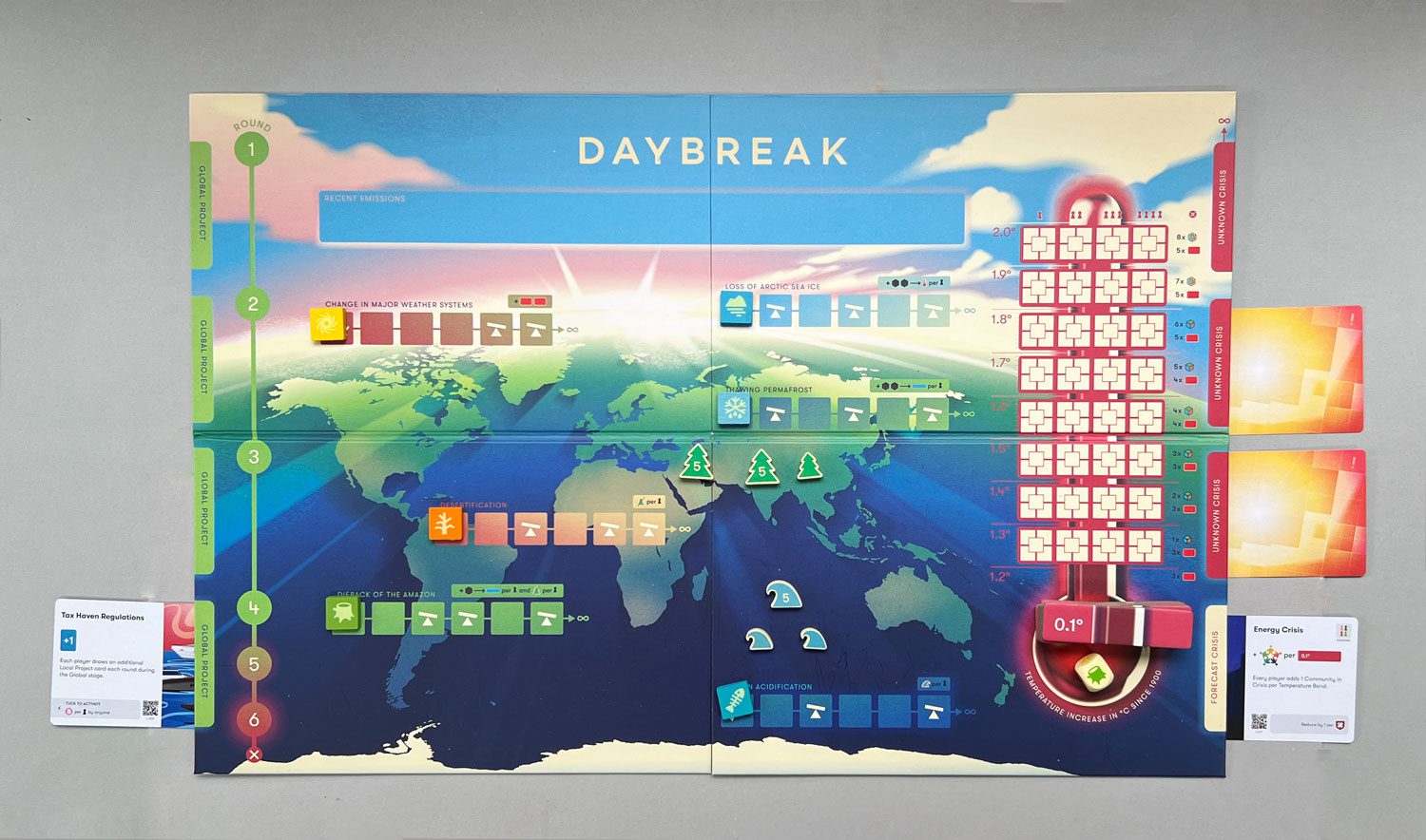
Shuffle the large deck of common Local Project cards and set them within reach of all players. Shuffle the Global Project cards and set them to the left of the board, then shuffle the Crisis cards and place them to the right of the board.
Playing the Game
At the start of each round, draw two Global Project cards and decide which one to keep.

You’ll then look at the number to the right of the thermometer and take that many Crisis cards. Turn the first one face up and leave the others face down.
At the start of each round, you will receive Local Project cards. You’ll start by receiving five cards, although this number may increase due to specific Local Projects or decrease based on Crisis card effects. Taking on too many Communities in Crisis tokens will also decrease the number of cards you’ll get at the start of each round.
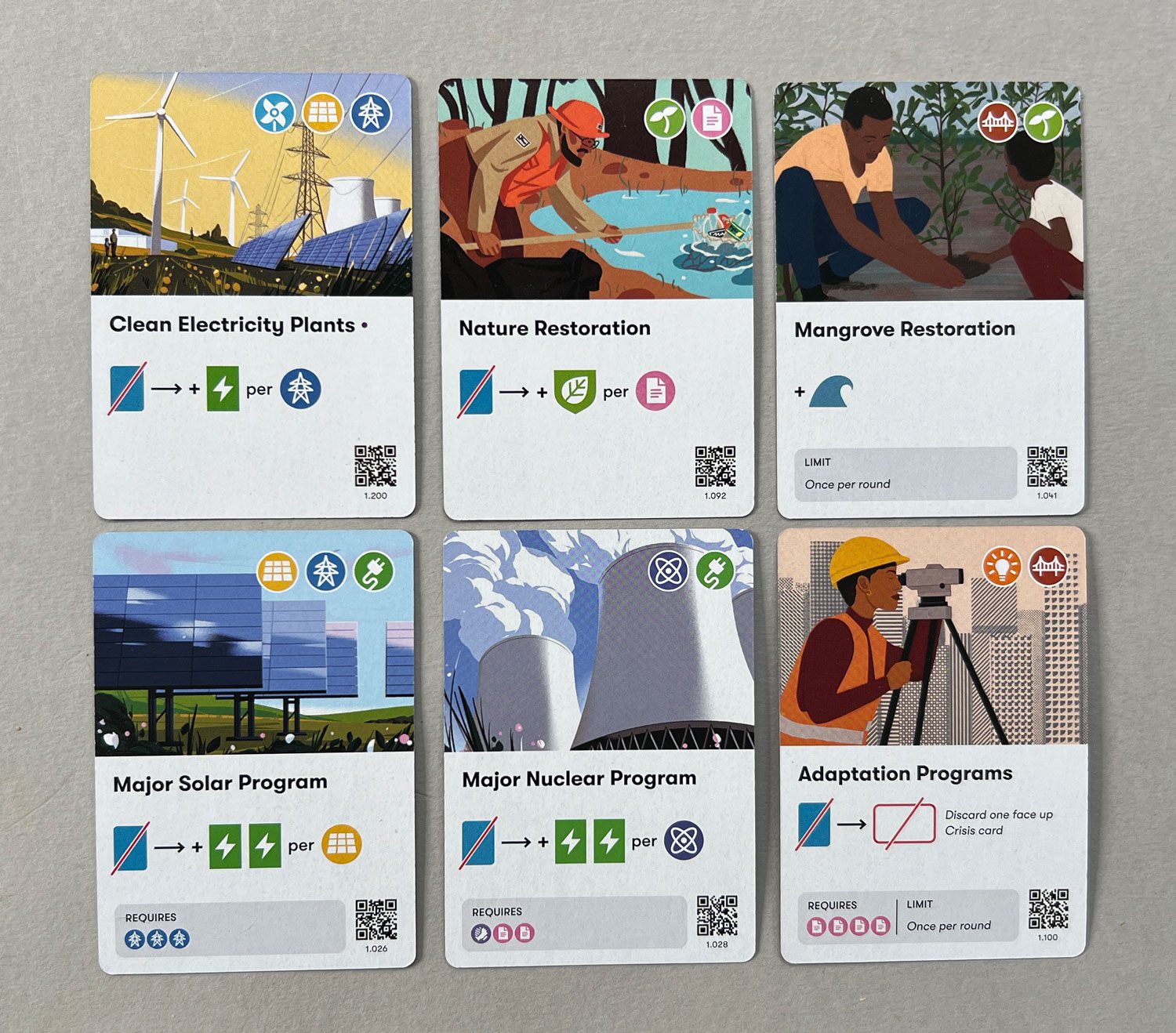
You will spend the majority of Daybreak trying to maximize the potential of these cards as part of your Local Projects. Local Projects can help you acquire additional resources and/or reduce emissions. To understand Daybreak is to understand how to use these multi-use cards.
Each card has a series of icons in the top right corner. These icons can be grouped together in a running vertical stack of cards to boost the visible card’s ability. Or, by placing it at the front of the stack, activating that card’s ability and making use of the tags in that group already in play.

For example, say I have the Clean Electricity Plants Local Project. The card states that I can discard another card to add a clean energy token to my player board for every Grid icon in that stack. Since the card itself has a Grid icon, I can do that once. However, if I tucked the District Heating card behind it, I could take the action twice.
If, on the other hand, I placed the District Heating card on top of the Clean Electricity Plants card, I could remove a Building’s dirty carbon emission from my board. This is because I now have the two Grid icons required for the action.
The Local Project phase also allows you to take the Clean Electricity Plants action, then place the District Heating card on top of it, to then take the District Heating action.
Once all players have taken all the actions they can or care to, it’s time for the Emissions Phase. Everyone adds up the dirty energy they’re still using and adds that number to all the carbon emissions their region is still producing. They’ll take that number of brown ‘carbon’ cubes and place them at the top of the board. Once the carbon from all players has been gathered, the cubes are dispersed amongst the Oceans and Trees on the board.
All remaining carbon cubes are added to the thermometer at the side of the board. For each player, there are five carbon spots before a temperature band fills up. This means for a two-player game, 10 carbon emissions will raise the temperature; for three players it will take 15 carbon.
To mark this, the cubes are removed and you’ll put a cardboard Temperature Band in their place. This indicates the global temperature has risen by 0.1º.
Chances are very good that on your first turn, you won’t be able to reduce much carbon from your board. This means the temperature may rise 0.2º or 0.3º. This not only means the planet is getting warmer, but negative effects listed to the right of the thermometer come into play. These include additional rolls of the Planetary Effects die (and the additional negative effects they cause) and an increase in the number of Crisis cards in play for each round.

Speaking of Crisis cards, the round ends with those Crisis cards coming into play. These always have negative effects, often causing players to accumulate additional Communities in Crisis tokens, or lose you Forest/Oceans from the board, or force you to remove cards from your Local Projects.
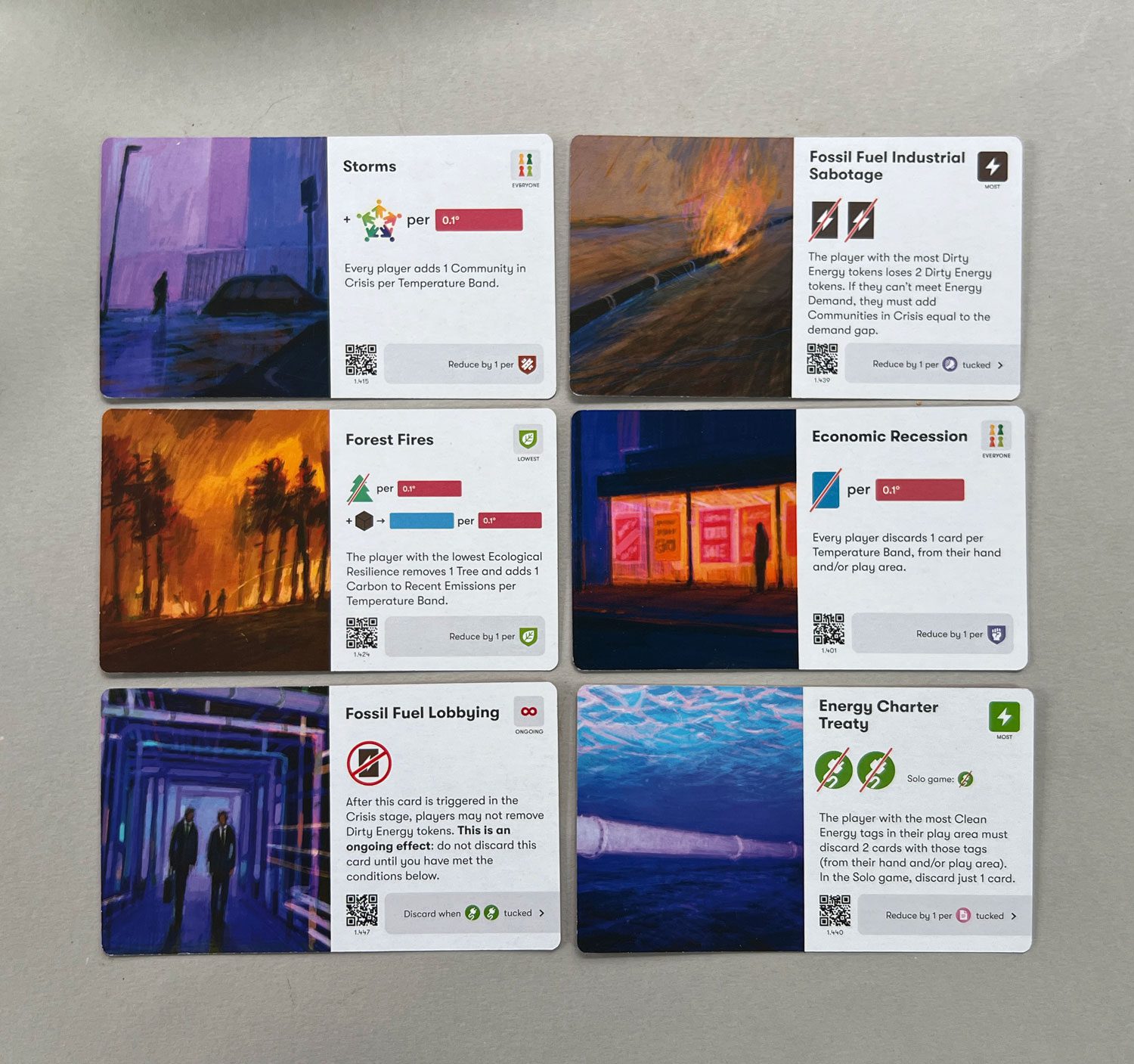
The goal is to reach Draw Down, a point where the carbon-absorbing tokens balance with, or are greater than, the total amount of carbon being emitted by all players. Then, players need to survive the final Crisis card effects to win the game.
All players lose if the temperature rises 0.8º or if any one player accumulates twelve Communities in Crisis tokens.
Thoughts
To prepare for this review, I played Daybreak about 15 times: once with four players, three times with two players, and the rest as solo games (mostly on BoardGameArena.com where, as of this writing, Daybreak is still in ßeta). I’ve also discussed Daybreak in-depth with one of the other reviewers here on Meeple Mountain. Our opinions on the game have differed. Those discussions have helped me clarify my thoughts on the game. (Thanks, Jesse!)
The Positives
The artwork throughout Daybreak is outstanding. I think Mads Berg understood his art should enhance the cards without distracting from the information on the card. His poster art approach allows the art to be evocative without calling too much attention to itself.
Another uniquely wonderful aspect of the cards is that each card has a QR code. That QR code links to the card’s specific page on the Daybreak board game site. There you will find details of the project/technology/concept/etc., depicted, as well as the rules for using the card within the game. Have a question about a card? Click the QR code with your smartphone and you’ll have your answer in seconds.
One last thing about the cards: if you’re into combolicious card games (to borrow a phrase from my friend and Meeple Mountain colleague Justin Bell), you should cast an eye toward Daybreak. It has one of the best rules regarding card play that I’ve seen in a while. To demonstrate, let me walk you through the following scenario:

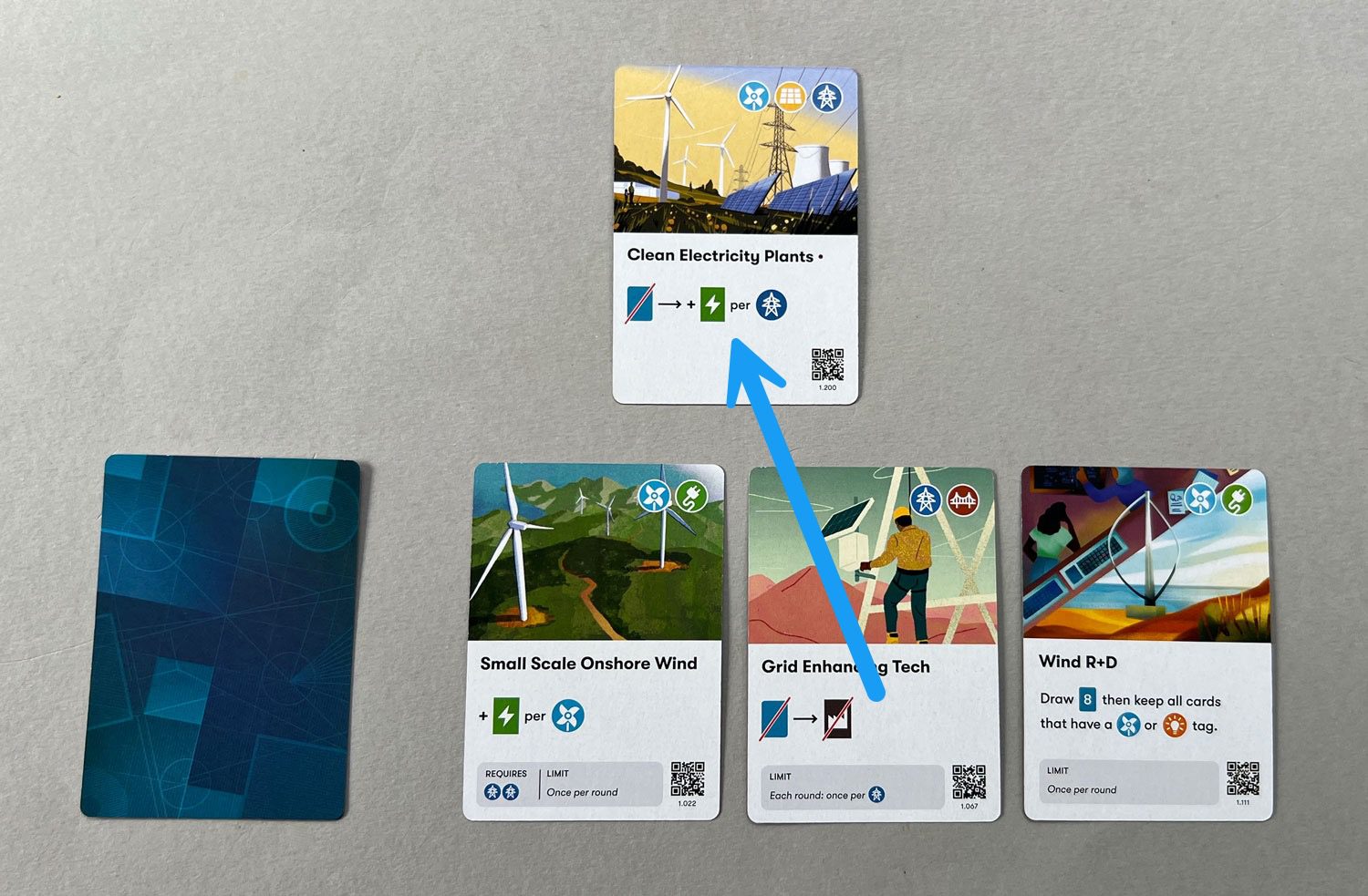
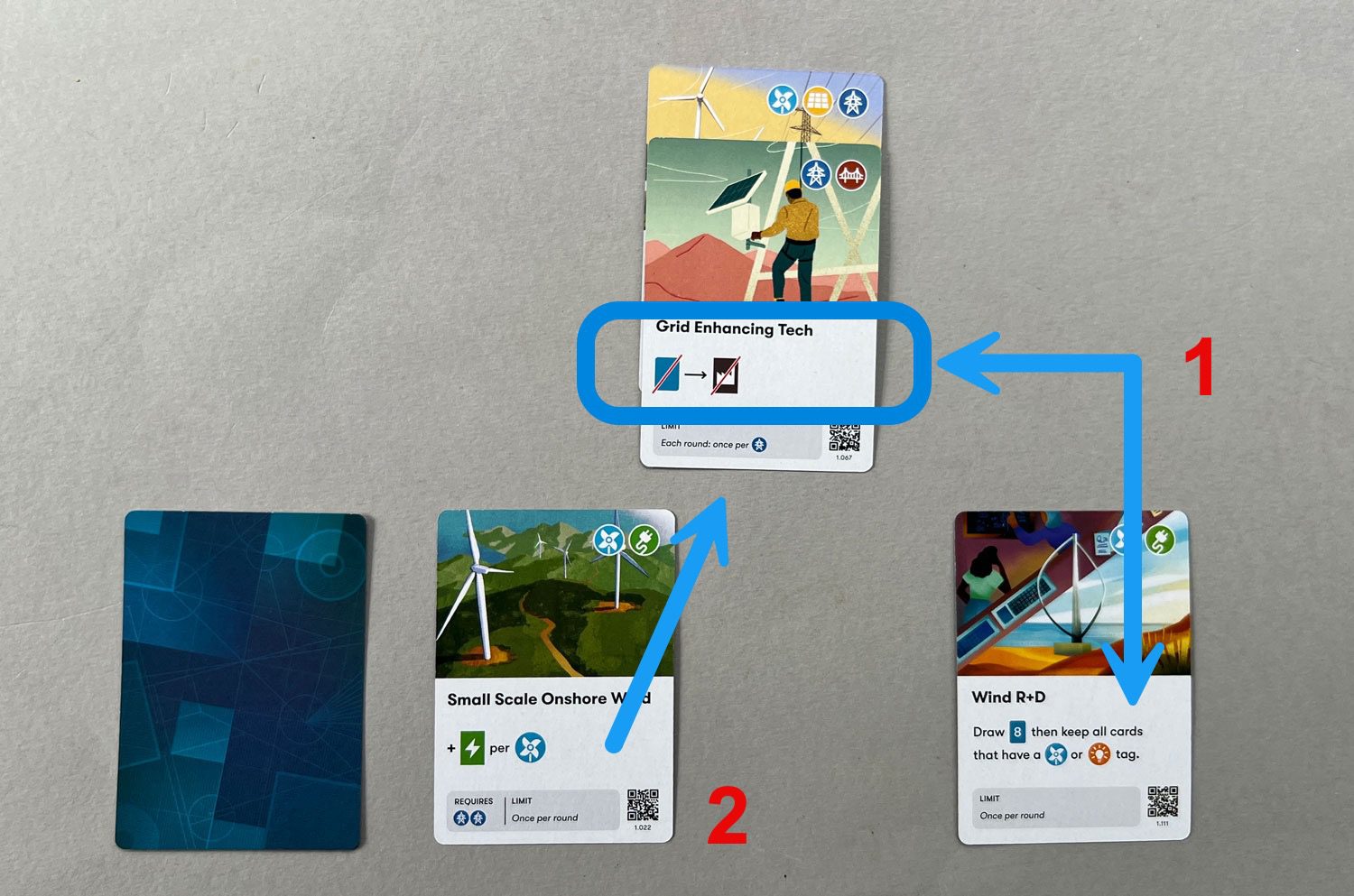
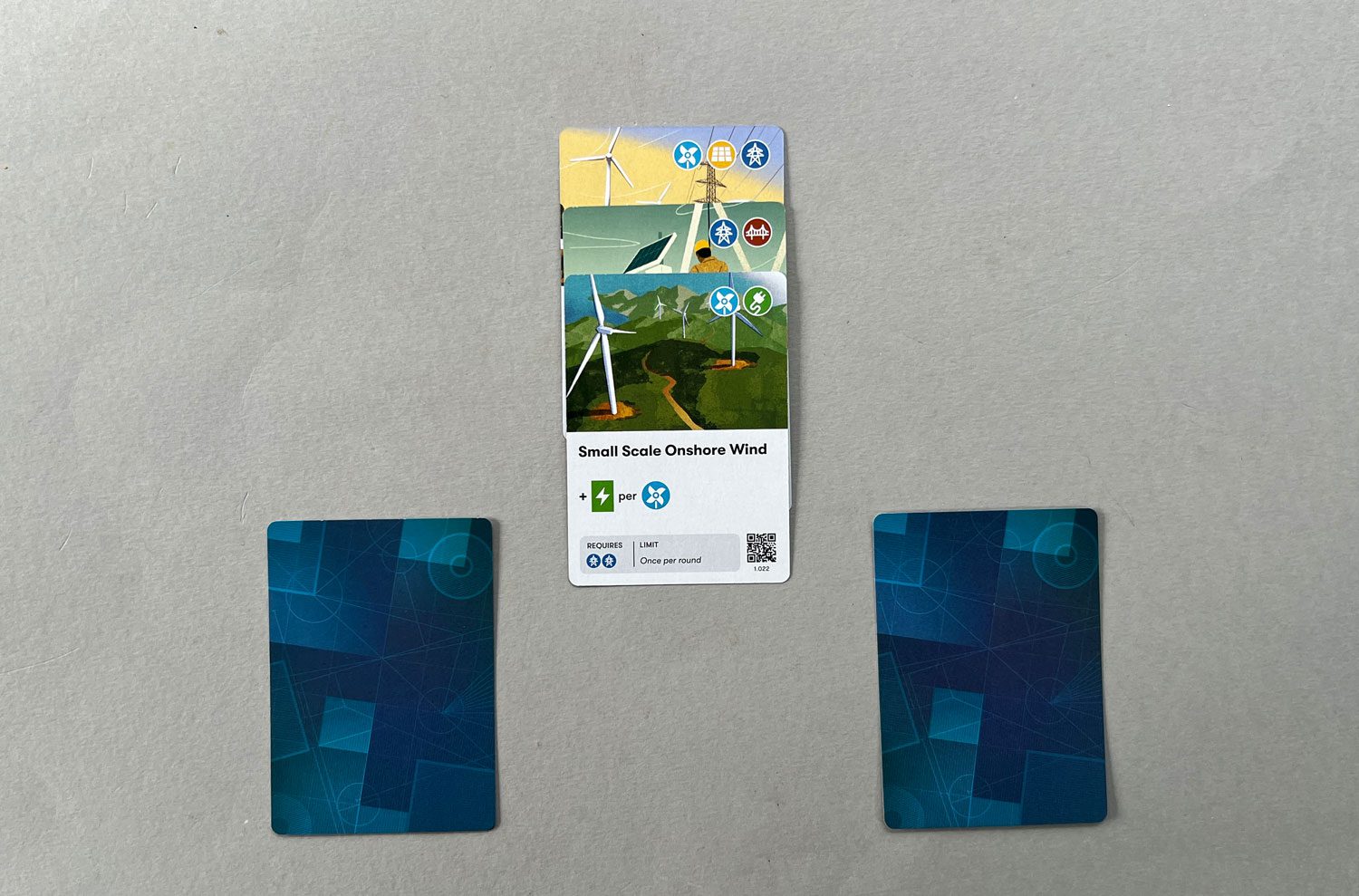
The way card icons are combo’ed is great: either boosting the frontmost Local Project’s action card by placing a card behind it or making use of the new card’s icons by placing it in front of them. Being able to do either is good; being able to do both in a single turn is pretty great.
The components are all well constructed. The wooden screened components for the trees, water, and the 5-carbon markers are thick and look great. All the player boards are two-layer cardboard, so the various cardboard indicators stay in place and are easy to add/remove.
The Negatives
Since Leacock designed one of the best-known games in the genre, comparisons to Pandemic are, for me, inevitable.
I’m a big Pandemic fan. It’s a challenging puzzle that fosters communication and cooperation, all while providing players with agency over their actions. Although I didn’t expect Daybreak to be Pandemic II, I did expect Leacock to carry over the elements that make Pandemic fun.
The Lack of Interaction
Where Pandemic is a group experience, Daybreak is multiplayer solitaire. This felt odd to me—we were all working towards the same goals, but largely unable to interact with one another. Although there are minor, case-specific exceptions, if another player needs help, they’re out of luck. If we’re world powers trying to save the planet, shouldn’t we be actively working together?
One of the players in my four-player session pointed out that the multiplayer solitaire aspect meant there was less of a chance of someone trying to Quarterback the game. While true, the lack of, well, cooperation in a cooperative game doesn’t work for me.
There’s Simply Too Much Luck
Your success in Daybreak is entirely dependent upon drawing the right cards from the top of the deck of Local Project cards. If you do, those comoblicious turns will not only feel good, but go a long way towards winning the game.
Getting the right cards early is essential because each player is going to start the game producing way more dirty carbon emissions than your initial water and trees can handle. Consider this: in a four-player game, the starting total carbon emissions are 91. The starting water & oceans are 40. If no one drops their emissions in round one, that’s a 51 point deficit.
The game allows five carbon per player per added temperature band (or 20 carbon in a four-player game), so that 51 carbon at the end of the first turn adds two temperature bands (20 x 4) and over half (11) of the third band. If that’s repeated on the second turn, that fills five of the eight bars on the thermometer, increasing the number of Climate Crisis cards from three to four and the number of Planetary dice rolls from two to four.
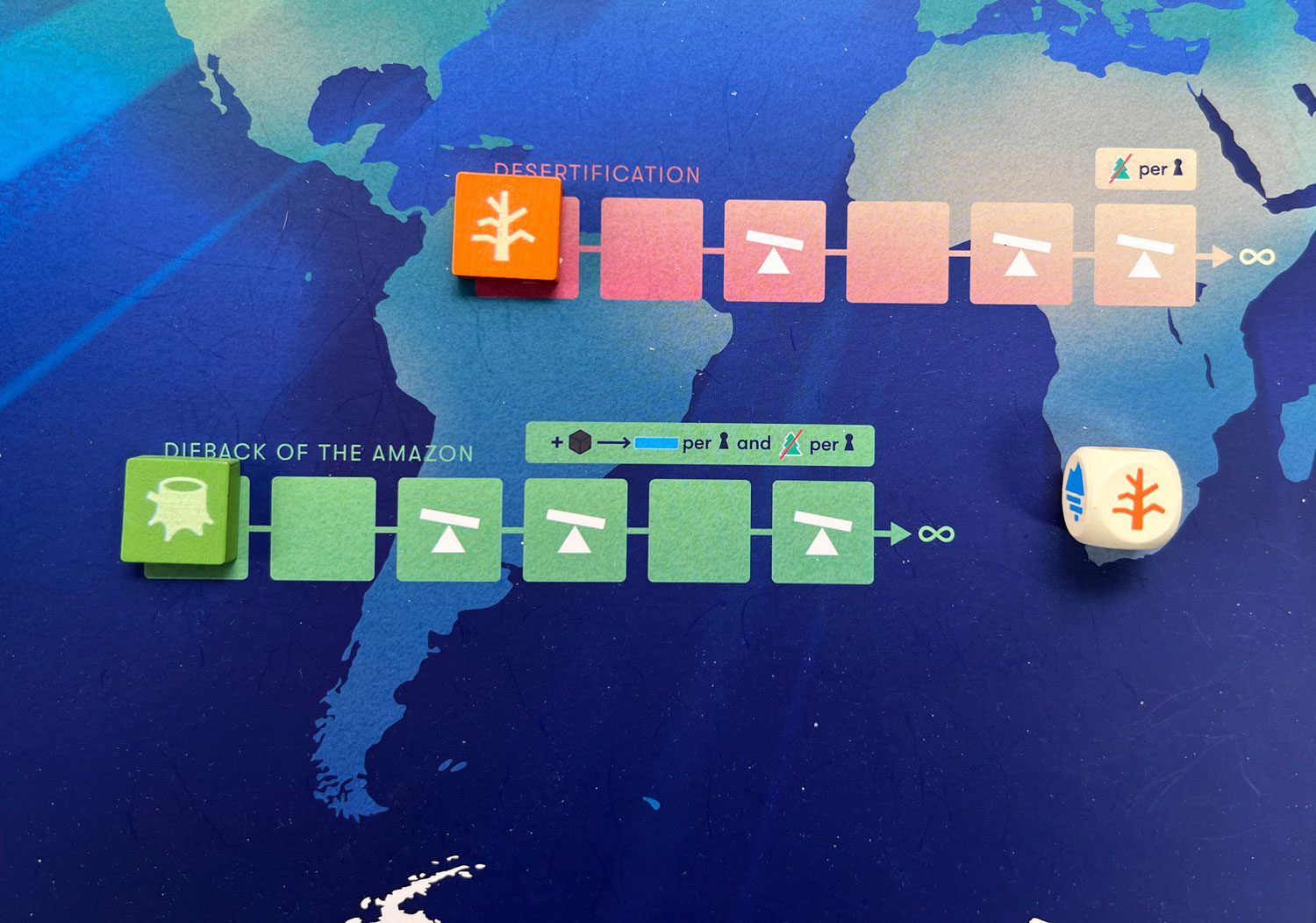
In the solo game, you’ll start with 23 carbon and only 10 trees and water. Not being able to reduce any carbon on the first turn fills four temperature bands.
Then, when the Crisis Cards are revealed, you may add additional carbon to the board and/or take on Communities in Crisis tokens, further hampering your game.When the cards do not come your way, you’re not only stuck, you’re quickly falling dangerously behind. With a deck of 150 Local Project cards, it’s not surprising that in only three of my games, I got the right cards at the right time. In fact, there were some games where my first two turns gave me no cards that worked together. That made for a miserable gaming experience.
Daybreak Punishes You for a Lack of Luck
I’ve always felt an agency with Pandemic that I find lacking in Daybreak. When I’ve lost at Pandemic, it hasn’t been for lack of trying. When I’ve lost at Daybreak, it was for a lack of the right cards the game requires me to have to win.
In theory, if you get the right cards, you can do some impressive combos and potentially win the game. In practice, the right cards have not shown up, leaving players with cards that don’t work together, causing a loss by the second or third turn.
When the outbreaks get worse in Pandemic, you still have all the actions and abilities you had at the start of the game. In Daybreak, when the temperature rise, you’re punished by getting fewer cards and having your carbon-absorbing resources (oceans & trees) reduced while the number of Crisis cards and rolls of the Planetary die increase.
The game does try to get around some of this by suggesting you can make your early games easier by increasing the number of water & trees and/or decreasing your initial carbon emissions. Daybreak also comes with a small deck of Scenario Cards with changes that decrease or increase the difficulty of the game. Being able to lessen the challenge begs the question, “Should I have to?”
Looking back at Pandemic, again, there were ways of increasing the difficulty. Decreasing the difficulty was never an issue, because the game was well-designed and balanced. I’m astonished that, given the number of playtesters listed in the back of the rule book, that Daybreak is as unforgivingly difficult as it is.
One of the four players in my weekly group is a huge Pandemic fan. At the end of that game, I asked if she’d be willing to play it again. She gave a resounding, “No.”
When asked what she took away from the game, she responded, “We’re doomed.”
Final Points
I want to point out that my Meeple Mountain colleagues, Jesse and Art Franz both like Daybreak. A lot. That’s one advantage of working with a dedicated group of gamers here at Meeple Mountain: we’re able to voice opinions while respectfully disagreeing.
For me, Daybreak was a disappointing and frustrating experience that only became worse the more I played it. As an enjoyable, cooperative game, Daybreak left me out in the cold.


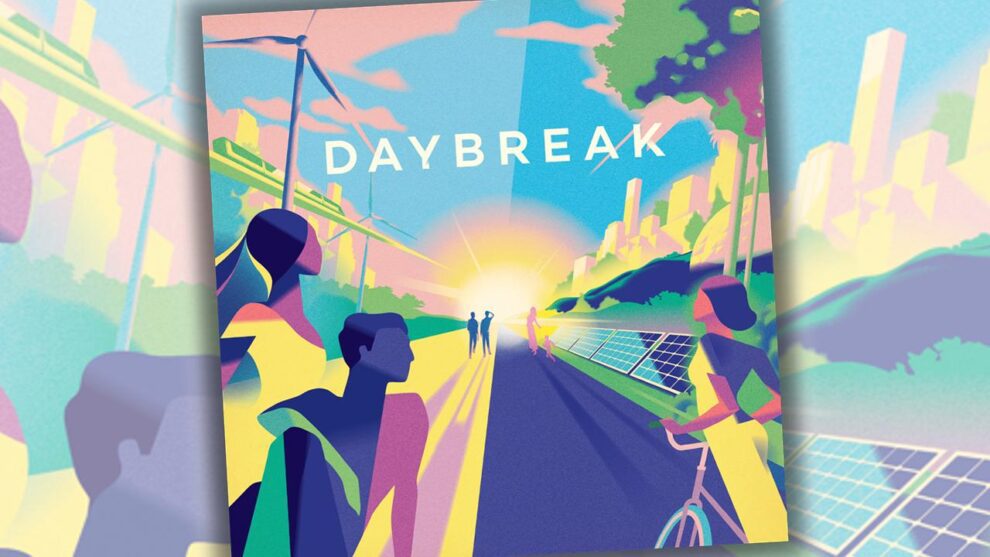

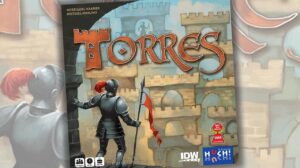
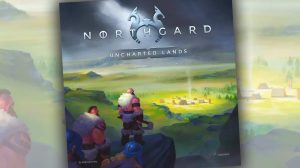






Thank you for this review, and I appreciate that it may have been a bit of a challenge to write.
I had recently watched MarcoOmnigamer’s impressions about Daybreak and he also mentioned the restrictions on player agency through card draw penalties, although he did not explain the double-whammy of fewer cards with the addition of carbon and/or removal of trees. I have become somewhat skeptical of games that claim to have tools that vary the difficulty, in part because this seems less like a way to allow individual players to calibrate their own challenge threshold but rather a “lazy” way to provide balance. It would be hard for me to say definitively (not having played the game yet), but it seems a modest reworking of the penalty schedule may have provided a more uniform and less frustrating experience than the one you reported without the need for editing the card pool.
You played the game in a number of player formats, identified specific elements that negatively impacted your enjoyment and highlighted the fact that your colleagues interpreted the qualities of Daybreak differently. The mediocre score sounds very reasonable, and yet I will probably still purchase this title in the near future because it’s generated enough positive reviews that I’m confident I can pass it on if my own experience is similar to your own.
Thanks again for sharing your thoughts about this title. 🖖
Thanks for your comment, Thomas. I appreciate it—especially your recognition that it was something of a challenge to write. It’s never easy to write a negative review, particularly one that has received such positive reviews elsewhere. (When I saw Daybreak appearing on several Top Ten games, I wondered if we had played the same game.)
The easiest way to adjust the difficulty is to increase/decrease the number of carbon-absorbing tokens (trees and water) at the start of the game. I tried that in some test plays of the cardboard version (you cannot adjust them in the BGA version) and after a few rounds, I realized I’d have to spend more time than I felt was warranted to figure out the “right” balance. That shouldn’t have to be my job.
My lasting impression of Daybreak is the way it punishes you for not being lucky enough to get Local Project cards that work well together. I don’t expect a co-op to be easy, but I also don’t expect it to seemingly chastise me for being on the losing side of such randomness.
That being said, I do hope your experience is different from mine. Please leave a follow-up comment and let me know your impressions of the game after you’ve given it a few plays. I’m genuinely interested in knowing how you like it.
Not the original commenter, but I also appreciate the review. I do agree luck plays a role, moreso in solo, but my conclusion about balance is the opposite of yours. I have played 10 games more or less evenly split over all player counts with 7 unique players and have only lost once. I have never adjusted the difficulty to make it easier, though I have added cards or swapped countries to make it harder. I don’t believe I’ve had a string of incredible luck, but rather that the game is well-balanced without being too hard for new or second time players.
My take on the challenge cards is that it’s great to have a mechanism to change the game from one play to the next and tune the experience if needed.